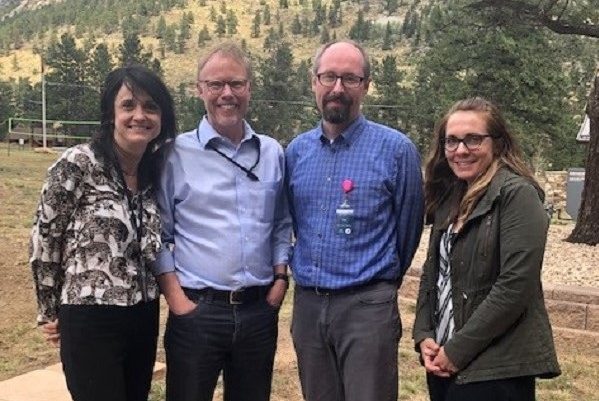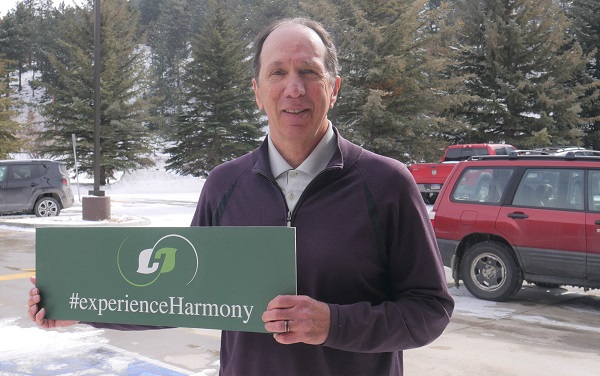Gina Thorne: Hi everyone. Welcome to the Harmony Foundation Podcast Series. I’m please today to be joined with Dylan Rivard who’s in private practice out of Golden and Boulder, Colorado. Welcome.
Dylan Rivard: Thank you. It’s great to be here.
Gina Thorne: Really excited to have you on campus today. Before we get into some details about your practice and what you do, we’d like to learn a little bit more about you first, so let’s talk about your background. How did you get into this field?
Dylan Rivard: Yeah. For me, it really started in working at summer camps in Vermont. It was not specifically therapeutic. It’s was just something to keep me busy between semesters in college. While I was there, I just discovered a fundamental shift in myself. I really like who I was living simply, being so connected to the earth and the woods, and saw that change both in my coworkers, the kids I worked with at this camp. I didn’t know exactly what that meant or how to pursue that. It didn’t really seem like a legit career, right? I just want to be a professional camp counselor.
Gina Thorne: That would be fun.
Dylan Rivard: Right. But then in pursuing it and looking at my options, I actually got an email from my dad pointing towards a masters in wilderness therapy at Naropa University out in Boulder, Colorado, and it was just perfect. It was the exact grad program I could have wanted. It was specifically designed for me, it felt like. And that is what kind of set me on the path.
Gina Thorne: That’s wonderful. I have to say, I was camp counselor as well, actually at Durango, Colorado. I wanted to figure out how can make this a life career myself.
Dylan Rivard: Nice.
Gina Thorne: So, I completely understand what you’re talking about.
Dylan Rivard: Yeah.
Gina Thorne: When I went to your website, I was really impressed by this modality that you have. You have this sort of three prong approach that you work with, but the thing that really stood out for me was that you’re trained in Hakomi, a Hopi Indian word that means how do you relate to all things, also called core therapy. For those of us that are new to this entire practice, can you describe what that means? And more specifically, what these five principles are and how you apply those to the work that you do in your practice.
Dylan Rivard: Sure. Really, the place to start with that is what it means to be a core therapy. As people, and we grow up, often there are incidence in our lives, often when we are very young, where we make some decisions about the world, about people, about ourselves, and these become what we could call core beliefs. Often, later in life, these become completely unconscious. We have not idea they’re running the show, but they’re there.
Dylan Rivard: Sometimes, people experience them in things like, in every relationship, not matter what’s happening, I don’t feel good enough, or I’ve got to stay busy all the time, if there’s open space for whatever reason, I get really anxious, so I just don’t even hangout there, we’re just going to skip right over that. Hakomi is specifically designed to drill into those types of experiences, those types of beliefs. Ultimately, the pain of those experiences, whatever set those up, that will probably never change, but the decisions we made about them, that’s where we really get to have some choice, and maybe even create more options in our lives versus how we’ve been running the whole show.
Dylan Rivard: The five principles of Hakomi, the framework through which we approach all those beliefs is mindfulness. It’s really about studying your experience from the inside out. I might offer some experiment or word, and really the emphasis then is on studying what happens. Suddenly, there’s tension and fear in my chest when you say that, or there are immediately thoughts like, that’s never going to happen. We get to learn more about that in that. I kind of pointed to this, there’s also a focus on a mind body connection, that everything that’s running your behavioral program has some relationship to your body, whether it be gestures or an internal felt sense. We really use that to move out of what’s kind of ordinary consciousness and start to access those realms that are a little more subconscious.
Dylan Rivard: In addition to that, there’s also this principle of nonviolence. Hakomi is not looking at blasting you through whatever the beliefs are, getting you to the other side. It’s really about honoring that whatever is there, it was put there for a really good reason. Actually, a classic Hakomi experiment is actually to just help you do those defenses more, to kind of take that over for you so you get a change to see, what’s it like from the inside of this? Do you get to have a different experience when someone else gets to take that protection for you?
Gina Thorne: Oh, that’s interesting.
Dylan Rivard: Yeah.
Gina Thorne: Really very fascinating. I think it obviously goes in line with your philosophy of what you do within your practice, which is really focusing on counseling wilderness, and also interesting was ceremony. Ceremony is always something that people equate to and they talk about religion, or they’re talking about spirituality. How would you look at that piece as it relates to the work that you’re doing?
Dylan Rivard: For me, I feel like spirituality is central to actually experiencing. A lot of what Hakomi points to is that internal sense of ourselves, that internal world that actually drives everything. And largely in our culture, it’s not given a lot of space. It’s really focused on external achievement, external presentation, but at the end of the day, the things people struggle with most, particularly in the realm of mental health, are these feelings of worthlessness, these feelings of fear, these feelings of emptiness, which are ultimately spiritual experiences. For me, that’s where spirituality feels really like core and central. I don’t mean to define that as any type of particular religion or a particular practice, but more about, how do you relate to your internal experience, and finding ways that actually can create a sense of fulfillment, connection, excitement. These are really things that are our birthright. Human practices have been around since the beginning of humanity. I know in our modern culture, it’s often true for people that those types of things have become really estranged or really distant.
Gina Thorne: And we do, we just disconnect ourselves from it because it’s uncomfortable or it’s not familiar, so we don’t know how to align ourselves with it, and that’s probably where we see a lot of addiction popping in too. Well, thank you for sharing that. That’s very interesting. You have a very unique practice. Just out of curiosity, I’m playing off this idea of harmony because you’re visiting with us from outside. What did it mean to you to live a life in harmony?
Dylan Rivard: It goes back similar to what the Hakomi word means. My mind goes right to, how do I relate to all things, both in the outer world, the people in my life, the nature in my life, but also all of those parts of myself that are online. For a lot of people, if you’ve not really examined yourself, it’s really easy to gloss over those or not even know they’re there, but any one point is like some little three year old inside of me. It was always looking for safety or those parts of myself that feel embarrassed or ashamed, it’s like all of these different things live inside me, and I think harmony is really about having the ability to open to each of those experiences. See them for what they are and not have to get rid of them or change them, but actually be able to work in cooperation with them.
Dylan Rivard: I think a lot of mental suffering comes from people identifying some of these parts, but then immediately going towards, I’ve got to get rid of it. I’ve got to change it. It’s got to be something different, and that’s actually in some way kind of violence towards yourself from yourself.
Gina Thorne: Yeah, you’re right.
Dylan Rivard: There’s really a much more powerful stance that I think where true healing happens where we get to accept those parts of ourselves that we feel like are kind of ugly, or unwanted, or maybe we’re a little less proud of.
Gina Thorne: Which actually makes part of who we are, right?
Dylan Rivard: Right. It’s part of our uniqueness.
Gina Thorne: That’s right.
Dylan Rivard: Often, they contain seeds of our superpowers or greatness as well.
Gina Thorne: It’s hard for people to see it that way because we’re always so focused on the negative and looking at the defects, but not really recognizing that those are actually a part of what makes us so special. That’s very interesting.
Gina Thorne: Dylan, if someone wanted to access your services, your amazing services that you offer, how could they connect with you?
Dylan Rivard: Yeah. Feel free to give me a call and setup an initial consult. That number is 720-633-4311. If you’re also curious and don’t know if you want work with me or not, just want more of a flavor, feel free to go to my website. It’s just my name.com. That’s dylanrivard.com.
Gina Thorne: Wonderful. It was good to have you on campus today. Thank you for coming.
Dylan Rivard: Thank you. It’s been a really wonderful visit. I very much enjoyed it.






